Railways Appeared in Toronto in 1852!
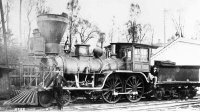
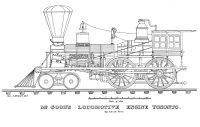
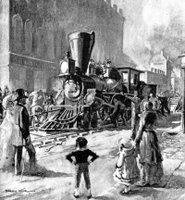
Click on each picture for a closer look!
.
The recent movement of steam locomotive No. 6213 from the Exhibition Grounds to Roundhouse Park echoes one of the most important events in Toronto's early railway history. Construction on the Ontario, Simcoe & Huron, Toronto's first railway, began in 1852. Since there was no locomotive factory in existence in Canada at the time, the OS&H ordered their first engine from the United States.
.
Built by the Portland Company in Portland, Maine, the engine was named the "Lady Elgin", in honour of the wife of the governor-general, the Earl of Elgin. She had turned the first sod of the Ontario, Simcoe & Huron Railway in October 1851 on the site of today's InterContinental Hotel at Front and Simcoe Streets.
.
Four days after being delivered to Toronto from Portland, Maine, the "Lady Elgin", the first steam locomotive to run in Canada West (Ontario), began operating at Queen's Wharf (Lakeshore Boulevard & Bathurst Street) while a large crowd of onlookers cheered the event. In 2009, 6213 passed within a few yards of this location on its June 4 journey from the Exhibition Grounds to Roundhouse Park.
.
The OS&H was unhappy with the extra costs incurred by customs duties as well as shipping the locomotive across Lake Ontario and sought a local builder for its next locomotive. The Lady Elgin was mostly used in construction work on the Ontario, Simcoe & Huron Railway. The engine proved underpowered and troublesome and was relegated to secondary operation by the time the railway began revenue service in 1853.
.
A local foundry owner named James Good decided that there was money to be made supplying steam locomotives to the burgeoning railway industry and the Toronto Locomotive Works was established at Yonge and Queen Streets, about where St. Michael's Hospital is today.
.
On April 16, 1853, the "Toronto", was completed at Good's foundry. This was the first steam locomotive built in Canada, and probably the first anywhere in the British Empire outside of Great Britain. The 4-4-0 weighed almost 30 tons and was 26 feet in length without her tender. Her four driving wheels were five and a half feet in diameter. On April 18, the "Toronto" was moved outside the locomotive works onto Queen Street for display to an appreciative public, who came from all over the city and suburbs to see it.
.
Just as with the movement of 6213 in 2009, it was decided to move the tender first, followed by the locomotive on a subsequent day. On April 19, 1853, the works crew spent all day loading the Toronto's tender onto a horse-drawn float outside the foundry at Queen and Yonge Streets and hauling it down Yonge to the nearest tracks on the south side of Front Street. The TLW hoped that the movement of the locomotive itself the following day would be less cumbersome since they planned on rolling it along rails laid in the street.
.
On April 20, the ponderous journey of the steam locomotive "Toronto" began. The 30-ton locomotive was far too heavy for the horse-drawn float used to move the tender the previous day. As in 2009, the locomotive would take a different route than the tender. Temporary track was laid relay-fashion 100 feet at a time and the engine was crow barred into motion west along Queen Street. At York Street the Toronto was swiveled south towards Front Street. This laborious process occupied almost a week, much to the fascination of Torontonians who had never seen such an enormous machine. People gathered along the route to cheer the progress of the locomotive through the streets, just as enthusiastic railfans would stay up all night to pace the progress of 6213 in 2009. Fortunately today's enthusiasts didn't have to wait as long. The Toronto didn't complete its week-long journey until April 26, 1853. For the next three weeks, the railway broke in the locomotive and the engineers became familiar with its operation before it was sent out on its first revenue trip.
.
On May 16, 1853, the most historic day in Toronto railway history the Ontario, Simcoe & Huron Railway initiated revenue railway service for the first time. The wooden depot was located close to where the eastern entrance to Union Station is today. The locomotive "Toronto" pulled the four car mixed train consisting of a coach, a combine and two boxcars to Machell's Corners, 30 miles north of the city. A year later the community was renamed Aurora.
.
The Toronto Locomotive Works (TLW) was seriously hindered by its inconvenient location a mile north of the rail corridor. After unsuccessfully trying to relocate to the waterfront, the TLW abandoned the railway business in 1859 after building 23 locomotives.
.
Here are the captions for each of the photos with #1 being the photo at the upper left and #6 being the photo at the lower right.
#1- The "Lady Elgin", the first locomotive to operate in Ontario, some years after it was delivered.
.
#2- The "Toronto" as it appeared in 1853 when it was built. There are no known photographs of the engine in its early years since photography was in its infancy in the early 1850's.
.
#3- The movement of the "Toronto" through the streets of the city. Although evocative, this romanticized image is inaccurate. The tender was moved separately and the locomotive is shown as it appeared after it was modified years later.
.
#4- This engraving shows a Toronto Locomotive Works engine in 1855 being hauled by horse teams past St. Lawrence Hall on King Street to the Grand Trunk Railway shops near the Don River. It would appear by this time that the foundry moved the boiler separately on a horse-drawn float and completed construction of the locomotive after it was delivered to the railway.
.
#5- The locomotive Toronto as it appeared in 1880, shortly before it was scrapped. We can only belatedly mourn the loss of what would undoubtedly be the most precious artifact of the railway era in any museum in this country, the first locomotive ever built in Canada.
.
#6- The Northern Railway (renamed OS&H) shops around 1860 looking southwest from Spadina. A locomotive can be seen outside the shops on the right. There's a possibility this was the "Lady Elgin", which was reportedly out of service by this time.
.
By Derek Boles, TRHA Historian
.
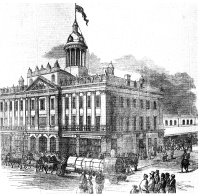
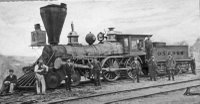
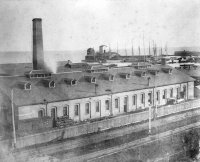
.






<< Home